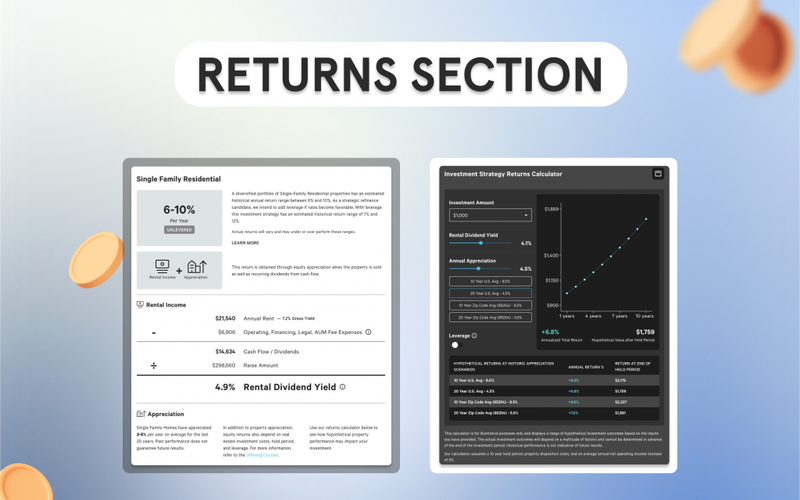At Arrived, we’ve always prioritized finding the best ways to communicate potential returns to our investors. We’ve spent a lot of time and effort on this since our inception, and our previous strategy has focused on demonstrating dividends alongside historical property value appreciation for each market.
While historical property values can be useful, they shouldn’t be the only factor considered in predicting future returns. We understand that some markets that have shown high appreciation rates over the past few years may not have much potential for further growth, while some markets that previously showed slower growth may be best positioned for significant expansion in the coming years. Each market is unique, and relying solely on historical market data may not always be ideal.
That’s why we’re thrilled to launch a new guide to potential returns that focuses more on the different investment strategies. This guide can help you understand the potential returns from Arrived investments and the risks and volatility that come with different asset classes.
We’re also rolling out a new historical returns section on all of our property pages and an updated hypothetical returns calculator that helps investors model different potential return scenarios. It’s our hope that these updates provide you with greater insights and confidence in your investment decisions with Arrived.
To better understand how to use our new guide, read the sections below that explain the significance of leverage on a real estate investment, how Arrived’s asset classes behave and perform, and why diversification is the ultimate strategy. Then watch our live webinar where Arrived experts weigh in on investment strategies and returns.
Arrived Investment Strategies & Returns
Asset Classes & Strategy
Arrived offers two investment classes: single-family residential and vacation rentals. Single-family residential rentals typically involve renting out a property for a year or longer, while vacation rentals are rented out on a nightly or weekly basis through platforms like Airbnb and VRBO. Both options offer their own unique advantages and disadvantages in terms of investment returns.
Single family residential properties tend to provide a more stable and predictable cash flow, as the lease agreement locks in the rental income for an extended period. This allows for more reliable planning and budgeting, making it easier to project and maintain a positive cash flow. Additionally, single family residentials typically require less maintenance and management, as residents are responsible for their day-to-day needs. However, the downside is that long-term rental properties may not generate as much income as vacation rentals, as rental rates tend to be lower and rental increases are limited by lease agreements.
On the other hand, vacation rental properties have the potential for higher income due to the nightly or weekly rental rates, and the ability to adjust rental rates frequently based on supply and demand. However, these types of rental properties may also have more variable occupancy rates and require ongoing maintenance and management to keep the property in good condition to handle guest needs. Additionally, vacation rentals may be subject to local regulations and restrictions, such as zoning laws or homeowner association rules.
Below is a breakdown of different investment strategies and their estimated historical return ranges for a diversified portfolio.
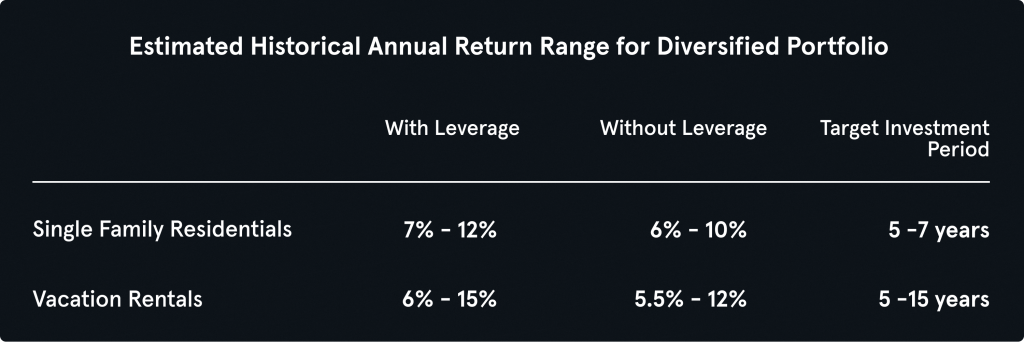
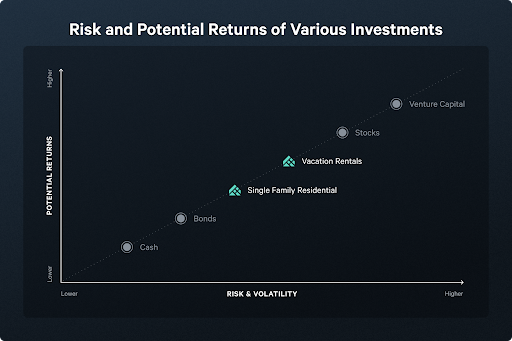
Returns Section
The new historical returns section is on all property pages and is built to help investors review the historical performance of past investments and understand potential returns. The focus is on displaying an estimated historical return range for a diversified portfolio of properties for each investment strategy. Actual returns for individual properties will vary and may over or underperform these ranges.
We also are introducing a projected rental income profit & loss for each property that breaks out topline rent, expected expenses, and expected cash flow.
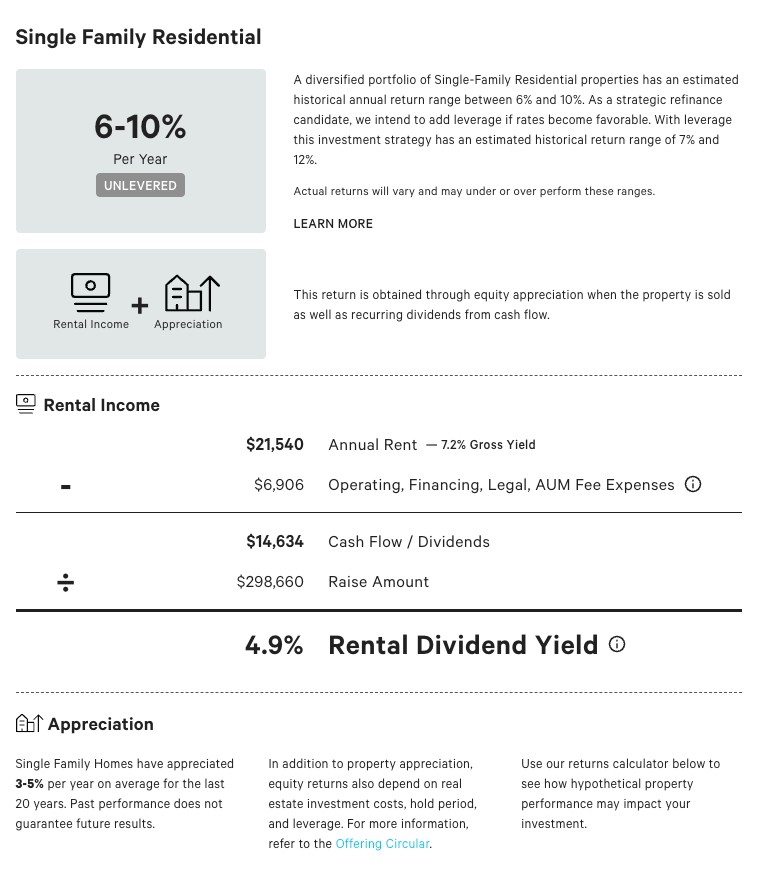
What is the Returns Calculator?
Arrived has developed a guide that will provide investors with an understanding of the potential returns and risks associated with the different asset classes of Arrived investments. This updated hypothetical returns calculator will allow investors to model different potential return scenarios. Check it out below!
Returns Calculator
We have updated our hypothetical returns calculator in a few different ways. First, we are moving to an IRR calculation method which also integrates the time value of money. Additionally, we now default to the national property value appreciation figures (vs. the market value appreciation figures) and include additional pre-determined appreciation figures for the 10 and 20-year historical averages for both the market and national data. Other changes include adjusting the holding period and adding disposition fees to the calculation.
We have also added a Leverage toggle to the calculator on Strategic Refinance Candidates so that users can easily understand the potential impact of adding leverage to these investments when interest rates fall.
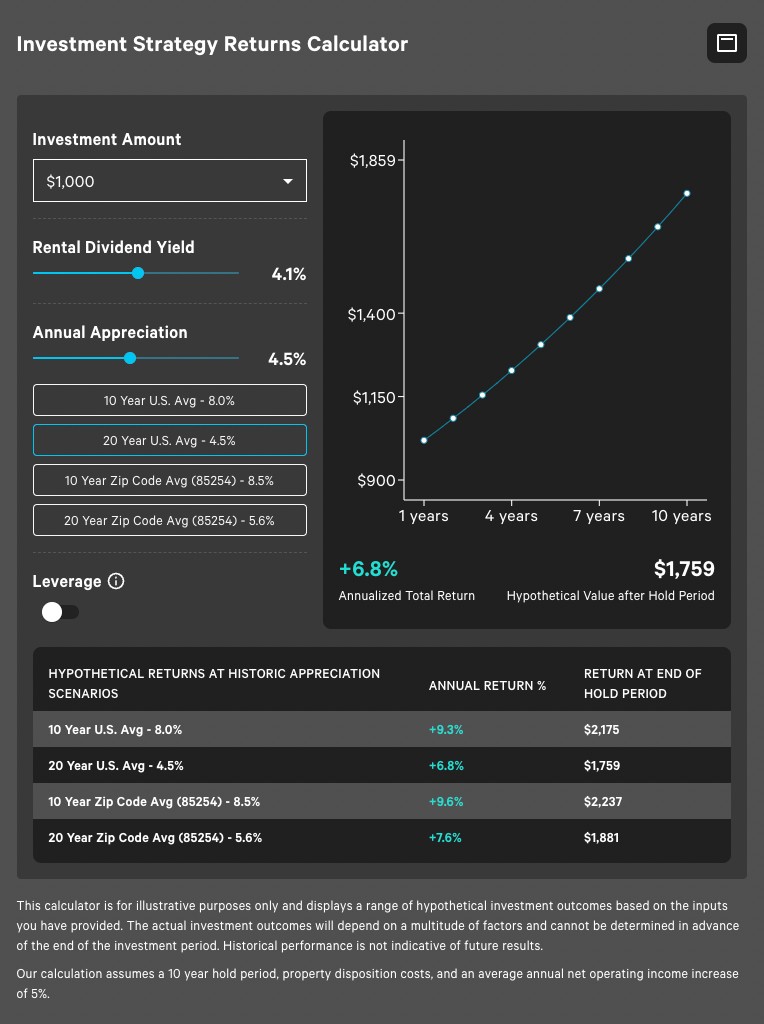
Impact of Leverage
Leverage can be a powerful tool for real estate investors, but it also comes with both benefits and drawbacks. On the one hand, leveraging a real estate investment allows investors to increase their potential returns. By borrowing money to purchase a property, investors can increase their buying power, potentially increasing their profits when the property appreciates in value. Additionally, the use of leverage allows investors to spread their risk over multiple properties or investments, further increasing their diversification and potential for success.
On the other hand, leverage also amplifies the risks of real estate investment. Leveraging an investment creates additional expenses in the form of interest payments and fees, which can erode potential profits if the investment doesn’t perform as expected. It is crucial to carefully consider financing options and have an understanding of the property’s potential for generating income and appreciation before making any investment decisions.
Using the returns calculator, investors can analyze the impact of leverage, or no leverage, for the potential returns on their chosen investments.
Diversification
Diversifying your real estate investments can help you build a more resilient and profitable portfolio that can withstand market fluctuations and deliver consistent returns over the long term. Let’s dig into what diversification is and how it can be a strategic tool in your investment process.
Diversification is the process of spreading your investments across a range of different assets, such as stocks, bonds, and real estate, rather than putting all your money into one type of investment. The main benefit of diversification is that it helps reduce the overall risk of your portfolio by spreading your investments across different assets that behave differently in response to market conditions. This means that if one asset class is performing poorly, other asset classes may be performing well, which can help offset the losses and help you achieve a more consistent return over time.
Diversifying your real estate investments between vacation rentals and single family residentials can offer several benefits. By investing in both vacation rentals and single-family residentials, you can spread your risk across the different asset classes and take advantage of their unique advantages. Vacation rentals can typically provide higher returns in the short run, especially in areas with high demand and limited supply, but they can also be more volatile due to fluctuations in the tourism industry and seasonal demand. On the other hand, single family residentials can typically offer steady cash flow and require less time and effort to manage but have a lower potential for appreciation and may be subject to vacancy risk.
Another benefit of diversifying between vacation rentals and single family residentials is that you can cater to different types of renters. Vacation rentals are ideal for travelers and tourists who are looking for a comfortable and convenient place to stay for a few days or weeks, while single family residentials are suitable for those looking for longer-term stability. By catering to both types of renters, we can increase our occupancy rates and reduce the risk of vacancies, which can negatively impact cash flow.
Overall, it’s important to diversify because it’ll help achieve a better risk-reward tradeoff and avoid overexposure to any single asset class or investment. Diversifying potentially increases returns while reducing overall risk. It’s important to note that diversification does not guarantee a profit or protect against losses, but it can help you manage risk and potentially achieve a more stable return over the long term.
Arrived Experts Talk Returns
Our experts held a live webinar to discuss Arrived investment strategies and how to use our newest guide. Watch it here or check it out below! It’s our goal to provide information that empowers investors to make the most well-informed investment decisions, and we’ll continue to enhance the returns calculator and returns section for every Arrived property.
